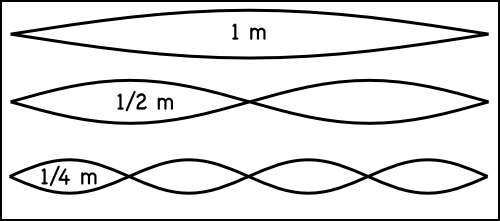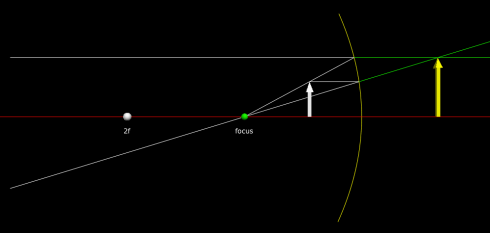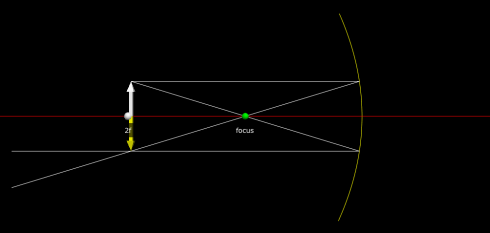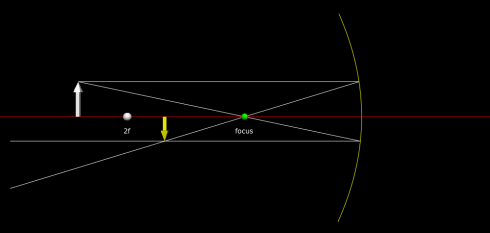Silvia Pelissero (aka Agnes-Cecile) brings a face to life in watercolor. (She has more, excellent videos on her YouTube channel).
Author: Lensyl Urbano
Octave Sound Samples
I’ve not had much real musical training, but enough to know that I have a terrible ear for sound and can’t reproduce a note for anything. However, an informed source tells me that octaves represent the same note at different pitches.
The pitch is the frequency of the sound wave.

If one note has twice the frequency of the other, they’re said to be one octave apart. For example, click on the image below to listen to the same note at different octaves:

Or play the files:
| Wavelength | Frequency | Sound File (mp3) |
|---|---|---|
| 1 m | 347 Hz | 1m.mpg |
| 0.5 m | 694 Hz | 50cm.mp3 |
| 0.25 m | 1388 Hz | 25cm.mp3 |
Foraging for Food
The Splendid Table has an enticing interview with Hank Shaw who just wrote a book on foraging for food in the woods and how to cook what you find. The book’s called, “Hunt, Gather, Cook“.
Shaw’s website is full of details about his adventures in foraging, as well as a lot of recipes — including some excellent photographs of the work in progress.
Why We Need to Sleep
Sleep patterns change during adolescence, but unless you can alter the school day, students need to figure out ways to deal with their predilection for going to bed and waking up late. Jason at FrugalDad has a nice compilation of statistics about why we need sleep. Particularly useful is the section on different ways to get more sleep. (I also like the fact that he cites his sources at the bottom.)
Source: ᔥhttp://frugaldad.com
How Black? 99.7% Black
One of my students asked, “How black can you get?” I didn’t know the answer; however, serendipitously, I ran into this article last night. Researchers in Rochester, NY have created a solar cell that absorbs 99.7% of incoming light, which means that it has an albedo (reflectivity) of just 0.3%. Since solar cells create energy by absorbing light, the more light it can absorb — the blacker the solar cell — the more efficient the solar cell is likely to be.
Expectations of Math
Jonathan Wai wonders, “Why Is It Socially Acceptable To Be Bad At Math?” After all, it’s not socially acceptable to be illiterate.
The cultural norm that it’s okay to be bad at math has deleterious effects on student motivation. I’ve seen it myself. One parent of an excellent, hard-working student confessed that it was probably her talking about how bad she was at math that helped her kid feel like they didn’t need to work that hard at the subject; especially since the student didn’t think that they were going to use the math anyway.
Some think that the solution is to use a more integrated curriculum and teach, “a math curriculum that focused on real-life problems,”:
Imagine replacing the sequence of algebra, geometry and calculus with a sequence of finance, data and basic engineering. In the finance course, students would learn the exponential function, use formulas in spreadsheets and study the budgets of people, companies and governments. In the data course, students would gather their own data sets and learn how, in fields as diverse as sports and medicine, larger samples give better estimates of averages. In the basic engineering course, students would learn the workings of engines, sound waves, TV signals and computers. Science and math were originally discovered together, and they are best learned together now.
— Garfunkel and Mumford, 2011: How to Fix Our Math Education in the New York Times
— ↬ The Dish ↬ Finding the Next Einstein
Which seems like a good idea — more of an apprenticeship-style approach to math — but there still needs to be some space for the wonderful elegance of some of the apparently more abstract math. More real world applications could certainly be incorporated into the current curriculum, but it would be short-changing our students if we just left math for problem solving and did not delve a little into the principles behind the mathematical techniques they’re using in a more general way.
Concave Mirror Ray Diagrams in VPython
I put together a VPython model to interactively illustrate how ray diagrams can be used to determine the appearance of an object in a concave, parabolic mirror. The video below demonstrates, but the code can be found here.
The white arrow is the object, and the yellow arrow shows it apparent magnification and orientation. You can drag the arrow around by its base, or make it taller (or shorter) by dragging the tip of the arrow up and down.
Summary of Appearance
When the object is closer to the mirror than the mirror’s focal distance then the object appears enlarged.

When the object is between 1 and 2 focal distances away from the lens, it still appears enlarged, but is upside down. (Note that at one focal distance away the object disappears entirely from the mirror.)

At twice the focal distance the object appears to be the same size but upside down.

Beyond 2 times the focal distance the object appears upside down and shrunken.

NOTE: To create images from VPython, and then convert them into a movie, I used this technique.
Wind Patterns (for the U.S.)

HINT.FM has an amazing animation of winds over the U.S.. A major part of the awesomeness is that it’s updated hourly from the National Weather Service’s weather database, which has an awful lot of excellent data available.

